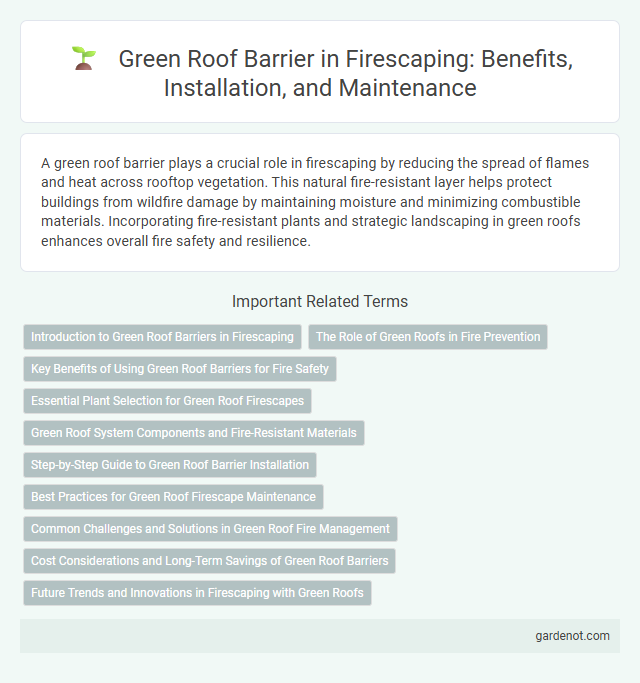A green roof barrier plays a crucial role in firescaping by reducing the spread of flames and heat across rooftop vegetation. This natural fire-resistant layer helps protect buildings from wildfire damage by maintaining moisture and minimizing combustible materials. Incorporating fire-resistant plants and strategic landscaping in green roofs enhances overall fire safety and resilience.
Introduction to Green Roof Barriers in Firescaping
Green roof barriers serve as critical defensive layers in firescaping, designed to slow or prevent the spread of wildfires across rooftop vegetation. These barriers consist of non-combustible materials such as metal sheets, gravel strips, or fire-resistant membranes that act as physical and thermal shields. Incorporating green roof barriers significantly enhances the fire resilience of vegetated roofing systems, protecting structures and reducing wildfire hazards in urban and wildfire-prone areas.
The Role of Green Roofs in Fire Prevention
Green roofs act as an effective barrier in fire prevention by retaining moisture in vegetation, reducing the intensity and spread of flames. Their layered structure with fire-resistant plants and soil minimizes heat transfer to the building below, limiting potential fire damage. Studies show that well-maintained green roofs can significantly slow wildfire progression, protecting urban environments.
Key Benefits of Using Green Roof Barriers for Fire Safety
Green roof barriers significantly enhance fire safety by creating a protective layer that slows or prevents the spread of flames across roof surfaces. These barriers are composed of fire-resistant materials such as mineral wool or non-combustible fabrics, which reduce heat transfer and improve the overall fire performance of green roofs. Incorporating green roof barriers helps protect structures from ignited embers during wildfires, reduces roof surface temperatures, and supports compliance with stringent fire safety codes in wildfire-prone areas.
Essential Plant Selection for Green Roof Firescapes
Selecting fire-resistant plants such as sedums, succulents, and native drought-tolerant species is crucial for creating an effective green roof firescape. These plants possess high moisture content and low flammability, helping to reduce fire spread and serve as natural fire barriers. Incorporating fire-resistant vegetation enhances roof safety while maintaining ecological benefits and aesthetic appeal.
Green Roof System Components and Fire-Resistant Materials
Green roof systems incorporate multiple components such as waterproof membranes, drainage layers, and growing media designed to support vegetation while enhancing fire resistance. Fire-resistant materials including non-combustible insulation, mineral wool barriers, and fire-retardant coatings play a critical role in reducing fire spread and increasing roof durability. Integrating these fire-resistant elements within green roofs helps create an effective green roof barrier that improves overall building fire safety and resilience.
Step-by-Step Guide to Green Roof Barrier Installation
Green roof barrier installation begins with selecting fire-resistant materials such as non-combustible membranes and insulation to enhance fire safety. The process involves cleaning and preparing the roof surface, applying a waterproof membrane, and securing the fire-resistant barrier with appropriate adhesives or mechanical fasteners. Final steps include layering growing mediums and vegetation suited for firescaping, ensuring proper drainage and regular maintenance to maintain the barrier's effectiveness against wildfires.
Best Practices for Green Roof Firescape Maintenance
Maintaining green roofs as fire-resistant barriers involves regular removal of dead vegetation, debris, and combustible materials to reduce fuel loads. Incorporating fire-resistant plant species with high moisture content and low resin levels significantly decreases fire risk. Periodic inspection of irrigation systems ensures adequate moisture, enhancing the green roof's capacity to act as an effective firebreak.
Common Challenges and Solutions in Green Roof Fire Management
Green roof fire management faces common challenges such as limited moisture retention, combustible plant materials, and difficulty accessing rooftop areas for firefighting. Solutions include installing non-combustible barrier layers, selecting fire-resistant vegetation, and integrating automated irrigation systems to maintain optimal moisture levels. Regular maintenance and strategic design also enhance fire mitigation by reducing fuel loads and improving emergency access.
Cost Considerations and Long-Term Savings of Green Roof Barriers
Green roof barriers require an initial investment that can vary based on materials and installation complexity, with typical costs ranging from $10 to $25 per square foot. Despite higher upfront costs, these barriers contribute to significant long-term savings by enhancing fire resistance, reducing energy consumption, and extending roof lifespan. Investing in high-quality green roof barriers lowers maintenance expenses and mitigates potential fire damage, providing cost-effective protection over decades.
Future Trends and Innovations in Firescaping with Green Roofs
Emerging technologies in firescaping emphasize advanced green roof barriers composed of fire-resistant vegetation and sustainable materials engineered to reduce ignition risks and enhance thermal insulation. Innovations in smart sensor integration enable real-time monitoring of moisture levels and fire threats, optimizing maintenance and rapid response. Future trends predict increased adoption of hybrid green roofs combining native fire-retardant plant species with innovative hydrogels that improve drought tolerance and flame resistance, setting new standards in urban fire prevention.
Green roof barrier Infographic

 gardenot.com
gardenot.com